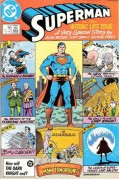Secret Origins…
October 20, 2013 Leave a comment
So, I was listening to one of my favorite podcasts, and they always ask the guest what got them into comic books. I’ve often wondered what it would be like to be on one of those shows, and how I would answer that question. And that got me thinking.
I certainly remember reading Archie comics as a kid. I also distinctly remember going to my paternal grandmothers and there being some comics lying around. I seem to remember one retelling Superman’s origin. And I distinctly remember watching the old George Reeves “Adventures of Superman” there a few times. But all that was as a kid.
I really got into the habit of collecting comics as a teenager. What age I don’t recall really. I know I wasn’t driving yet, because I had to either pester my mother to drive me to the store (same store I went to almost every week for 20 years), or ride my bicycle there. And it was a very long bike ride. But I digress.
And this is where things get interesting. When I look back at it, I can think of two different comics that really got me hooked. The first is Star Trek Vol. 1 #1 by DC Comics, and the other was John Bryne’s “Man of Steel” relaunch. Now, here’s the thing: Star Trek came out in February of 1984. Man of Steel came out in 1986. Two years. Pretty big difference, right? Well, it gets better.
Looking at what I have left of my comics collection, puts those titles as being the gateway drug into question. In my collection is all 12 issues of DC Comics “Crisis on Infinite Earths,” which came out in 1985. I also have Superman Vol. 1 #423, Part 1 of “Whatever Happened to the Man of Tomorrow,” which came out in September, 1986. I also have Macross #1, which wa published by Comico back in 1985.
So, just looking at this, and doing the math, the winner is STAR TREK #1. For the next few weeks, this blog will take a look a each of these issues, and see if we can turn back the pages of time and find out what made those books so special.











Recent Comments